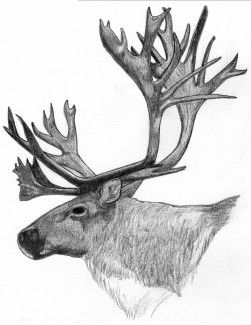
Johns Hopkins UniversityEst. 1876
America’s First Research University
Wild Thing: Deer antlers, bones of contention
Wild Thing is an occasional series where JHU Press authors write about the flora and fauna of the natural world—from the rarest flower to the most magnificent beast.
Guest post by George A. Feldhamer


Almost all species of deer have antlers—the only one that doesn’t is the Chinese water deer. As most people are aware, only male deer have them—again with one exception: female caribou also are adorned. The size of an individual’s antlers depends on its overall body condition (which depends on availability of good habitat), genetics, and age. Peak antler size is attained during middle age; very young or very old animals tend to have smaller antlers.
Antlers are different from horns, which we see on antelope, sheep, and cows. Unlike horns, antlers are made of bone, have tines, usually are found only on males, and are deciduous, that is, they are shed every year. Antlers are not an “extravagance of nature,” but are highly useful. They primarily function as weapons and indicators of status. Antlers allow males to establish dominance hierarchies with other males for access to females. To mix a metaphor—the top dog has the biggest antlers. Antlers' use as defensive weapons against predators is a secondary benefit.
The yearly antler cycle of deer in temperate regions is closely tied to the changing seasons and is driven by the relative length of daylight and night. As day lengths increase in spring, antlers begin to grow. They are full grown before the fall mating season. Antlers are shed in winter, following the mating season, when day lengths become shorter. Growing a set of antlers is very energetically demanding—they are the fastest-growing vertebrate tissue, including cancer. They can get really heavy as well—moose are the largest living deer and their antlers can weigh up to 77 pounds. Antlers are certainly “monuments to calcium metabolism,” so why do deer shed them every year just to start growing them again within a few months? It would appear to be a terrible waste of energy and not very adaptive.
There are several reasons deer shed antlers. Because they are used to fight or spar with other males, antlers may break. If not replaced yearly, a broken antler (or cumulative breakage over several years) could seriously reduce an otherwise healthy male's chances to mate. Also, energy needed to carry antlers through the winter, when males are already metabolically stressed, may be substantial. Casting antlers also may make males less visible to predators in winter. Finally, antlers can keep up with increased body size as a male grows only if they are cast and grown again each year. Despite appearing to be energetically wasteful, there are good reasons why deer shed and regrow antlers yearly.
As noted, female caribou generally have antlers. The reasons are related to geography, habitat, and behavior. Caribou inhabit the Northern Hemisphere at high latitudes, with low temperatures, much snow and ice in winter, and limited food. Most adult female caribou are further stressed during winter because they are pregnant. Antlered females can displace males from limited available feeding sites because the cows retain their antlers later into the winter than do bulls. Reindeer are simply domesticated caribou—and of course they pull Santa’s sleigh. During the winter, male reindeer have dropped their antlers, and as noted only females retain them. So, Rudolph, Dancer, Prancer, and the rest of Santa’s team—all with antlers at Christmas time—must be females!



